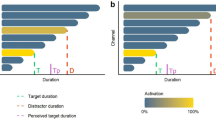We report here a number of characteristics of the perception of short time intervals by humans (duration up to 3 sec). A short range of time intervals was assessed using a large set of durations (50) differing from each other by a small amount (0.06 sec). This provided the first identification of the structure of the subjective scales by which subjects evaluate the durations of time intervals in the range studied. Analysis of the distribution of the standard deviations of evaluations of interval durations showed that these scales were discontinuous and could include only eight gradations, and this was supported by an additional series of experiments.
Similar content being viewed by others
References
N. D. Bagrova, The Time Factor in Perception by Humans [in Russian], Nauka, Leningrad (1980).
Yu. V. Bushov and N. N. Nesmelova, “Individual characteristics of the perception of the durations of time intervals by humans,” Fiziol. Cheloveka, 20, No. 3, 30–35 (1994).
G. Woodrow, “The perception of time,” in: Experimental Psychology [Russian translation], S. S. Stevens (ed.), Foreign Literature Press, Moscow (1963), Vol. 2, pp. 859–874.
V. I. Galunov, “Psychophysiological and psychological scales,” in: Questions in the Theory and Methods of Investigation of the Perception of Speech Signals. Information Sources of the USSR Academy of Sciences [in Russian], Joint Scientific “Human and Animal Physiology” Council Press, Leningrad (1969), Iss. 22.
S. V. Zimina, “Clinical characteristics of the perception of time by humans,” Institute for the Study of the Nature of Time, www.chronos.msu.ru/RREPORTS/zimina_kliniko.html.
S. L. Zysin, “Evaluation of the position of a point on a line,” in: Studies of the Principles of Information Processing in the Visual System [in Russian], Nauka, Leningrad (1970), pp. 129–141.
L. I. Leushina, The Visual Perception Space [in Russian], Nauka, Leningrad (1978).
V. P. Lisenkova, “The individual characteristics of the reflection of time by humans and the time characteristics of a number of autonomic and motor reactions,” in: The Perception of Space and Time [in Russian], Nauka, Leningrad (1969).
I. Marinova and L. Mitrani, “Scaling of short time intervals presented visually,” in: The Psychophysics of Sensory Systems[in Russian], Nauka, Moscow (1979), pp. 149–153.
J. A. Miller, “The magic number seven plus or minus two. Some limits to our ability to process information,” in: Engineering Psychology [Russian translation], D. Yu. Panov and V. P. Zinchenko (eds.), Progress, Moscow (1964), pp. 192–225.
M. B. Pavlovskaya, The Mechanisms of Evaluation of the Magnitude of Visual Images in Humans [in Russian], I. P. Pavlov Institute of Physiology (1977).
G. V. Portnova, O. V. Sysoeva, N. V. Malyuchenko, M. A. Timofeeva, M. A. Kulikova, A. G. Tonevitskii, M. P. Kirpichnikov, and A. M. Ivanitskii, “Genetic bases of time perception in sportsmen,” Zh. Vyssh. Nerv. Deyat., 57, No. 4, 450–461 (2007).
O. V. Sysoeva and A. V. Vartanov, “Two cerebral subsystems foe encoding stimulus duration (part 2),” Psikhol. Zh., 26, No. 2, 81–90 (2005).
P. Fress, “The perception and evaluation of time,” in: Experimental Psychology [in Russian], P. Fress and J. M. Piage (eds.), Progress, Moscow (1978), No. 6, pp. 88–130.
L. A. Chistovich and V. A. Kozhevnikov, “The perception of speech,” in: Questions in the Theory and Methods of Investigation of the Perception of Speech Signals. Information Sources of the USSR Academy of Sciences[in Russian], Joint Scientific “Human and Animal Physiology” Council Press, Leningrad (1969), Iss. 22.
G. S. Shlyakhtin, “Transformation of the mechanisms of the subjective evaluation of the durations of short time intervals,” in: N. I. Lobachevskii Nizhegorod University Bulletin, Social Sciences Series [in Russian], Nizhnii Novgorod State University Press, Nizhnii Novgorod (2004), Iss. 1, pp. 81–86.
D. G. Él’kin, The Perception of Time [in Russian], APN RSFSR, Moscow (1962).
H. Atmanspacher, M. Bach, T. Filk, J. Kornmeier, and H. Roemer, “Cognitive time scales in a Necker-Zeno model for bistable perception,” Open Cybern. Syst. J., 2, 234–251 (2008).
D. M. Eagleman, P. U. Tse, D. Buonomano, P. Janssen, A. C. Nobre, and A. O. Holcombe, “Time and the brain: how subjective time relates to neural time,” J. Neurosci., 25, No. 45, 10369–10371 (2005).
H. Eisler, “Subjective duration and psychophysics,” Psychol. Rev., 82, No. 6, 429–450 (1975).
G. Koch, L. Brusa, C. Caltagirone, M. Oliveri,A. Peppe, P. Tiraboschi, and P. Stanzione, “Subthalamic deep brain stimulation improves time perception in Parkinson’s disease,” Neuroreport, 15, No. 6, 1071–1073 (2004).
E. Poeppel, “Time perception,” in: Handbook of Sensory Physiology, H. Autrum et al. (eds.), Springer (1978), Vol. 8, pp. 713–729.
E. Poeppel “The measurement of music and the cerebral clock: a new theory,” Leonardo, 22, No. 1, 83–89 (1989).
J. M. Riesen and A. Schnider, “Time estimation in Parkinson’s disease: normal long duration estimation despite impaired short duration discrimination,” J. Neurol., 248, 27–35 (2001).
J. West, G. Douglas, S. Houghton, V. Lawrence, K. Whiting, and K. Glasgow, “Time perception in boys with attention-deficit/hyperactivity disorder according to time duration, distraction and mode of presentation,” Child Neuropsychol., 6, No. 4, 241–250 (2000).
Author information
Authors and Affiliations
Corresponding author
Additional information
Translated from Zhurnal Vysshei Nervnoi Deyatel’nosti imeni I. P. Pavlova, Vol. 60, No. 4, pp. 430–437, July–August, 2010.
Rights and permissions
About this article
Cite this article
Podvigina, D.N., Lyakhovetskii, V.A. Characteristics of the Perception of Short Time Intervals. Neurosci Behav Physi 41, 936–941 (2011). https://doi.org/10.1007/s11055-011-9512-8
Received:
Accepted:
Published:
Issue Date:
DOI: https://doi.org/10.1007/s11055-011-9512-8




